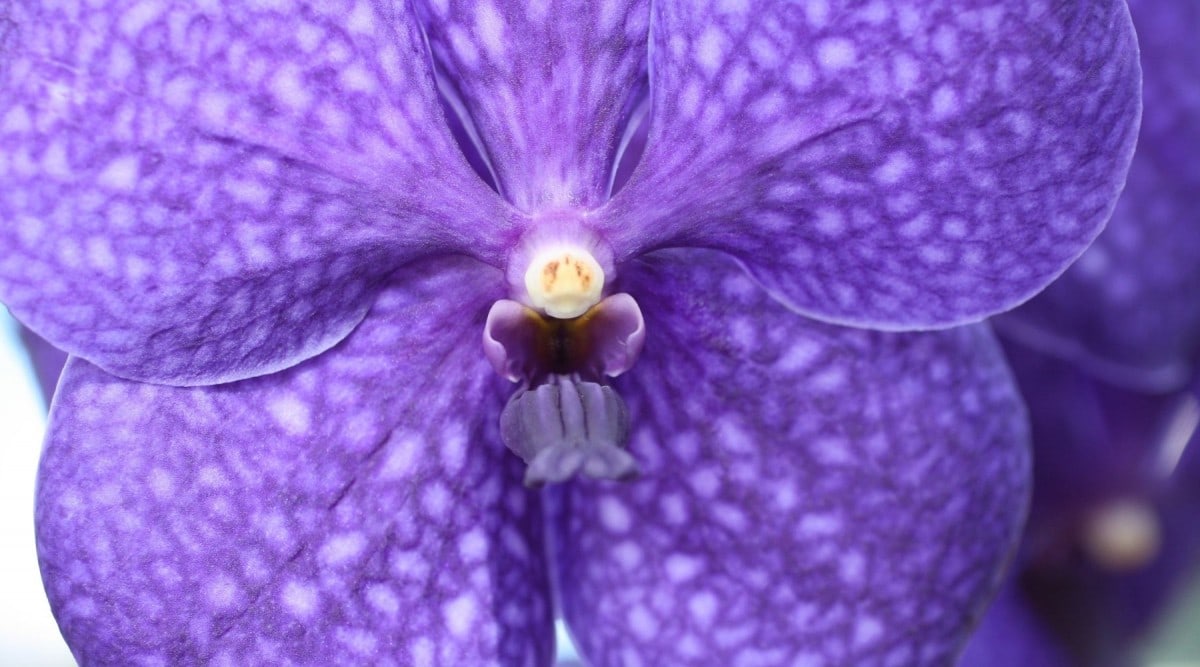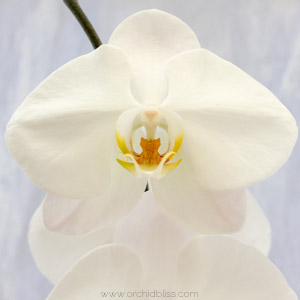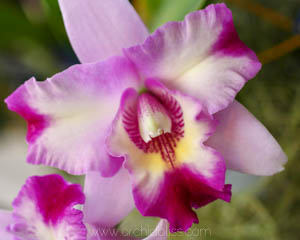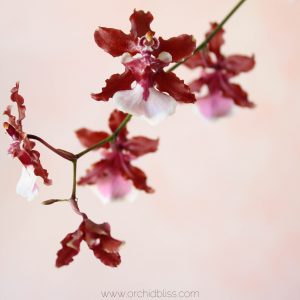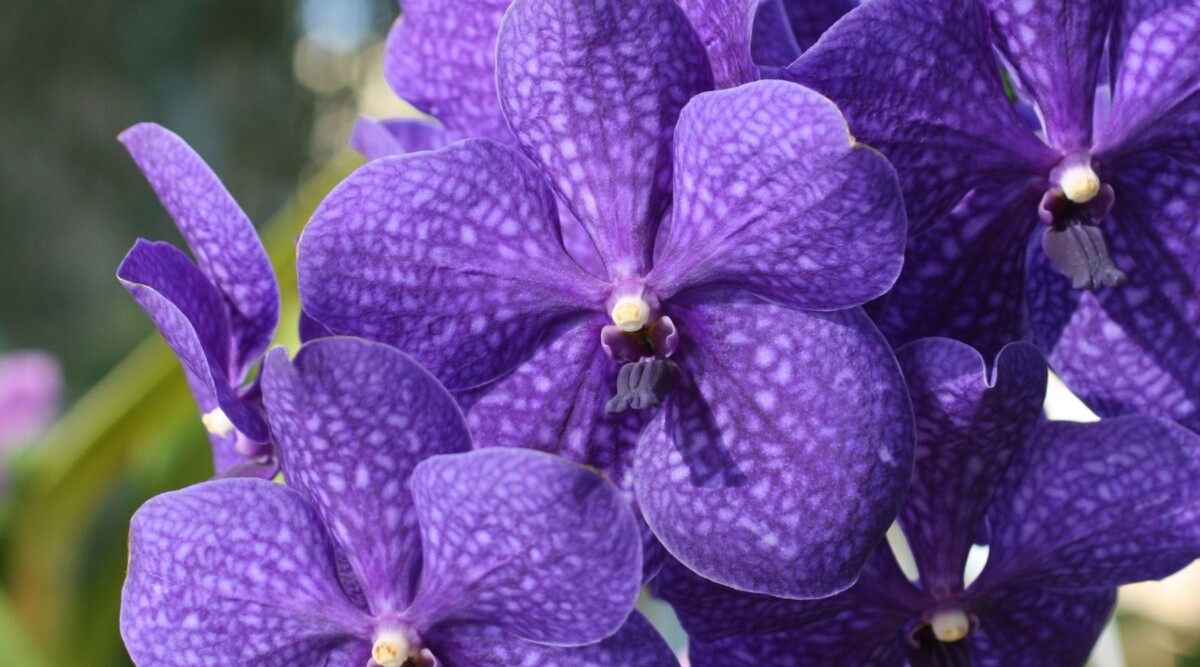
9 Best Orchids for South Florida
Orchids are popular flowering plants among homeowners and gardeners because they are exotic and beautiful, with so many species and hybrids to choose from. Different species thrive in different growing conditions, so some orchids may be easy to grow, while some are quite challenging. There are also orchids that thrive in certain places or certain climates where others won’t.
In Florida, it is generally hot and humid, so many types of orchids would thrive here. The best orchids for South Florida are Phalaenopsis, Cattleyas, Paphiopedilums, Dendrobiums, Epidendrums, Oncidiums, Spathoglottis, and Vandas. They are either temperature-tolerant or love a tropical climate.
This article will talk about these orchids and what makes them the ideal kinds of orchids to grow in South Florida. Specifically, we will discuss in more detail the favorable growing conditions for these orchids and how the state can provide these conditions for them.
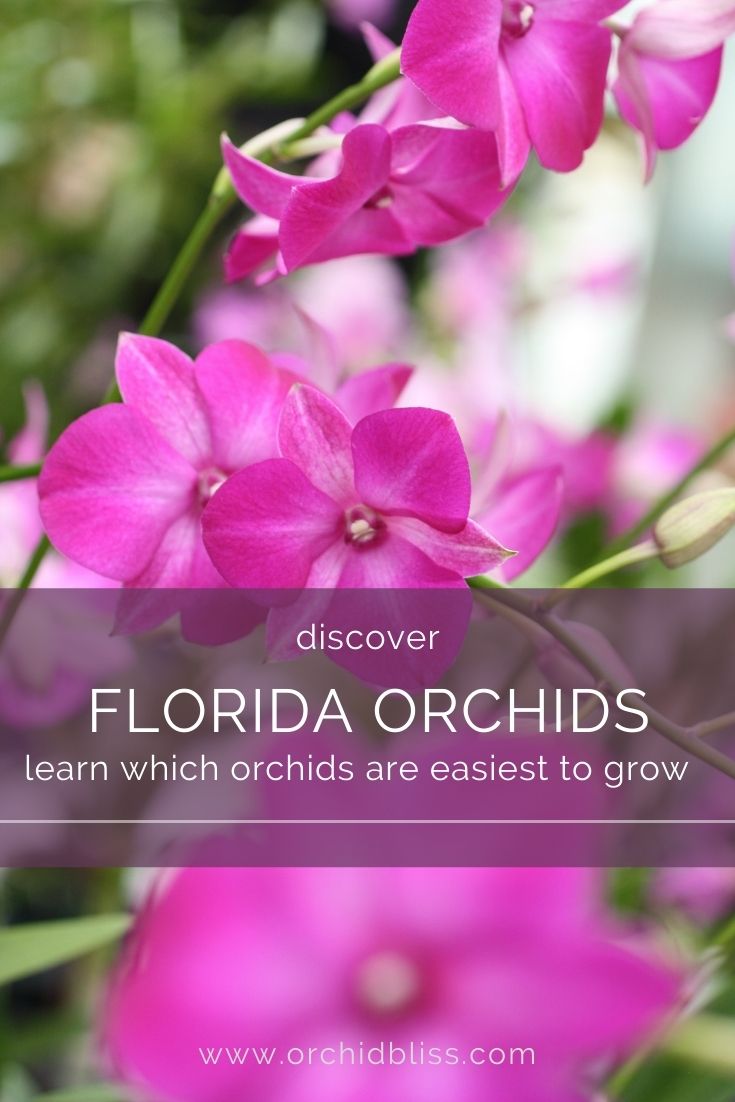
Some of the links on this page may be affiliate links. Click here to learn more.
Florida’s Climate and Seasonal Temperatures
The southern part of Florida is tropical, while the northern and central parts are humid subtropical. The months of October until late April make up the dry season, interrupted only by brief and light winter rainfalls. It can also get extremely dry in mid and late winter. Meanwhile, May to October comprise the rainy season, wherein thunderstorms build in the day’s heat and drop brief yet heavy summer rainfalls.
Temperatures in the summer are the same throughout the Sunshine State, especially during the day, ranging from 88 to 91 degrees Fahrenheit (31 to 33 degrees Celsius). It is warmer at night as you head south, ranging from 70 degrees Fahrenheit (21 degrees Celsius) in the far north to 81 degrees Fahrenheit (27 degrees Celsius) in the Keys.
The high humidity during the summer makes the heat uncomfortable, although there are also intensely hot periods of up to 100 degrees Fahrenheit (38 degrees Celsius). It is often sunny, but it can get cloudy, too. Cloudiness can lead to thunderstorms, which sometimes come with wind gusts or, less frequently, with hail. The good thing is that these thunderstorms don’t last long and would quickly make way for the sun.
Meanwhile, during the winter, temperatures are very varied. In January, the daily average temperature ranges from 52 degrees Fahrenheit (11 degrees Celsius) in the north to 68 degrees Fahrenheit (20 degrees Celsius) in the south.
Tornadoes are quite common in Florida, but these are generally much weaker than the tornadoes that hit other parts of the country. Sometimes, intense tornadoes occur in the spring or winter due to the sudden intrusions of cold air.
June to November is the season of tropical storms and hurricanes, although they’re more likely to occur from August to October. The coastal areas are the most at risk for these calamities because of storm surges from the sea.
Orchids: What You Need to Know
Orchids make up the largest flowering plant family, with over 25,000 species and hybrids of over eight times that number. This speaks of these plants’ sheer diversity, which can be attributed to their ability to adapt and live a long time.
While they can be found all over the world, from the very cold to the very hot regions, the majority of the species that are cultivated and grown as houseplants are native to regions with a tropical climate. These species generally grow on tree branches and not on the forest floor. Because of this, cultivated species require air circulation and a specific amount of lighting.
To understand an orchid’s basic requirements, you need to take into consideration the location and the environment of its natural habitat.
Basic Light, Temperature, and Humidity Requirements
Generally speaking, orchids need the following:
Light
Some orchids can be very strict about light, especially when you grow them indoors. Some species love exposure to high light or unobstructed sunlight, while others prefer low light conditions.
And you can always tell whether your orchids have been exposed to too much sunlight because brown or dark reddish spots would appear on their stems. Meanwhile, orchids that are lacking in sunlight are usually deep green.
Temperature and Humidity
Because most house orchids are native to the tropics, they can be sensitive to abrupt changes in temperature. So always check your orchids and make sure their needs are met. For one, you need to maintain both low and high temperatures.
Plants that are native to tropical regions are also used to higher humidity compared to the average room. So for your orchid to stay healthy, put it on top of a tray with pebbles, then add some water. You also need to provide airflow. So, in case you notice that your orchid is in bad shape, you can try adding an electric fan to your room.
Phalaenopsis
Phalaenopsis, also known as moth orchid, is a great orchid for beginners because it is among the easiest to grow and requires minimal maintenance. Even with a little care, it can bloom year in and year out. It will do well in South Florida because this orchid likes humidity, and it can take the heat.
However, even if it is heat- and humidity-loving, this orchid is considered a low-light one and does not like to be placed in full sun. You can place your Phalaenopsis indoors but make sure it is out of direct sunlight. You will also need to maintain a room temperature of 70-80º F/26.7º C, with about a month of intermediate temperatures of 55°-60º F/ 13°-15.6º C in the winter to trigger blooming.

This orchid can be expected to be in full bloom by mid-summer.
The Phalaenopsis has thick roots that need a less dense and more open potting material, such as an orchid bark medium. You can water it once a week. An orchid that shares a pot with moss needs to feel dry to the touch before you may water it again. But if you are in doubt, you can just wait one day more.
Moreover, make sure to let the orchid drain entirely. If any of the water remains in the orchid’s crown or where its leaves come together in the center, you can simply dab it with a paper towel to soak up the water.
Also, whatever you do, never plant your Phalaenopsis in soil because it will rot.
After your phalaenopsis finishes blooming you may wonder where to cut the flower spike. To help you further, start by downloading my free cheat sheet to see where to cut the orchid flower spike after blooms have faded to trigger re-blooming. Click here, for the cheat sheet. It’ll be super helpful.
Cattleyas
Cattleyas are the most popularly grown among all types of orchids. They need precise light to grow and flower properly. It is another orchid that will be able to tolerate and thrive in Florida’s climate.

Florida’s temperatures are, in fact, considered ideal for growing Cattleyas. These plants will thrive with the 80 percent humidity, the breeze, and the constant heat in the spring, summer, and fall. Cattleyas are also impressively resilient to the cool winter nights when the temperature goes down.
Cattleyas prefer to be exposed to light from the east, west, or shaded south window. Do not forget to water your plant when its medium is totally dry. It is also a great idea to do a light misting in the morning during particularly dry summers. Just make sure your Cattleya doesn’t fall victim to overwatering or underwatering.
Paphiopedilums or Slipper Orchids
Paphiopedilums require high humidity to thrive. This is why South Florida is perfect for this orchid. However, they also want constant moisture during the hot summer. And because these orchids are terrestrial and grow on the forest floor in their native habitat, 60 to 70 percent shade is considered ideal for them. Otherwise, their leaves will burn.
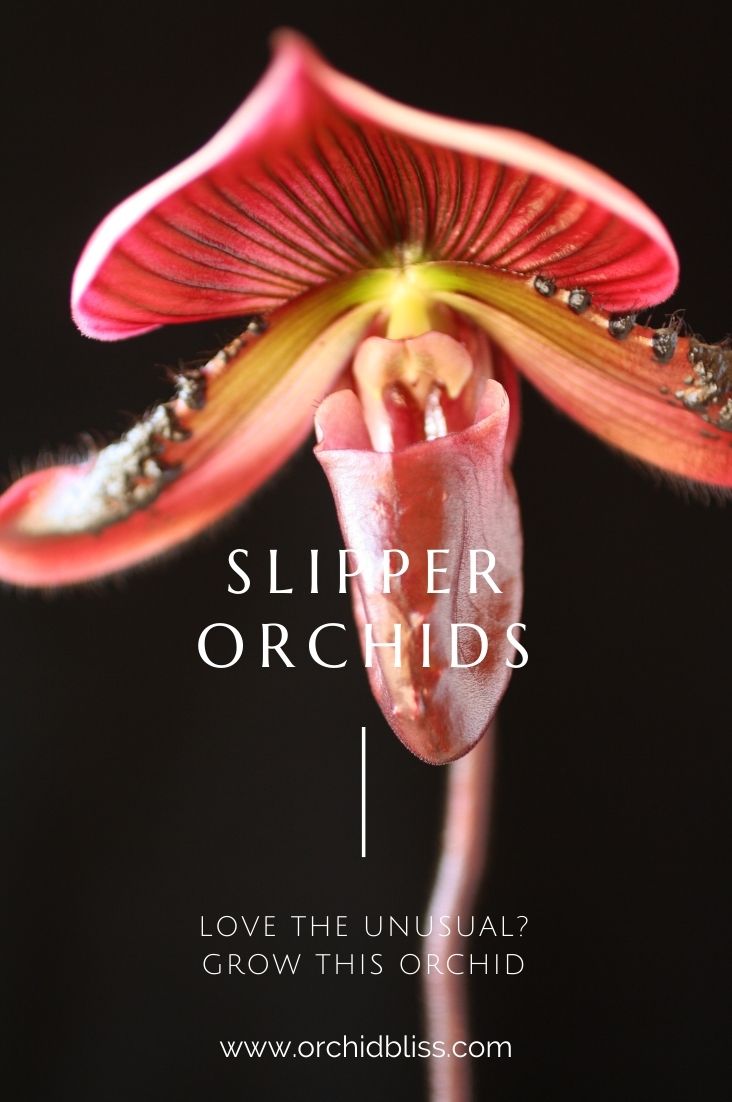
To produce flowers, these orchids need lots of light, although low light conditions are fine with them. They also like warm temperatures. If your orchid has spotted markings, keep the temperature between 70-80º F/26.7º C. Common Paphiopedilums or those without markings on their leaves 55-60º F/ 13-15.6º C.
Check their pots often during warm or hot months to ensure that their much-needed moisture is provided at all times. Water them every few days, typically at a five-day interval. Check your orchid from time to time and see whether the top layer of its potting medium feels dry. However, be sure not to water it excessively.
Dendrobiums
You may find Dendrobiums confusing as there are two main types. There are the intermediate growers or the evergreen dendrobiums, which thrive in intermediate climates and temperatures similar to the ones required by Cattleyas. Then there are cool growers, which go through a dormant period in the winter and defoliate or drop their leaves in the process.
The evergreens would need water all year long, while the cool growers need very little water.
In their natural habitat, cool growers experience wet summers yet cool and dry winters. If you have a cool grower, keep it in a bright place with indirect sun, preferably by a southern window. Water it every couple of days, or three, during the summer, then fertilize them weekly. Discontinue the routine when fall comes.
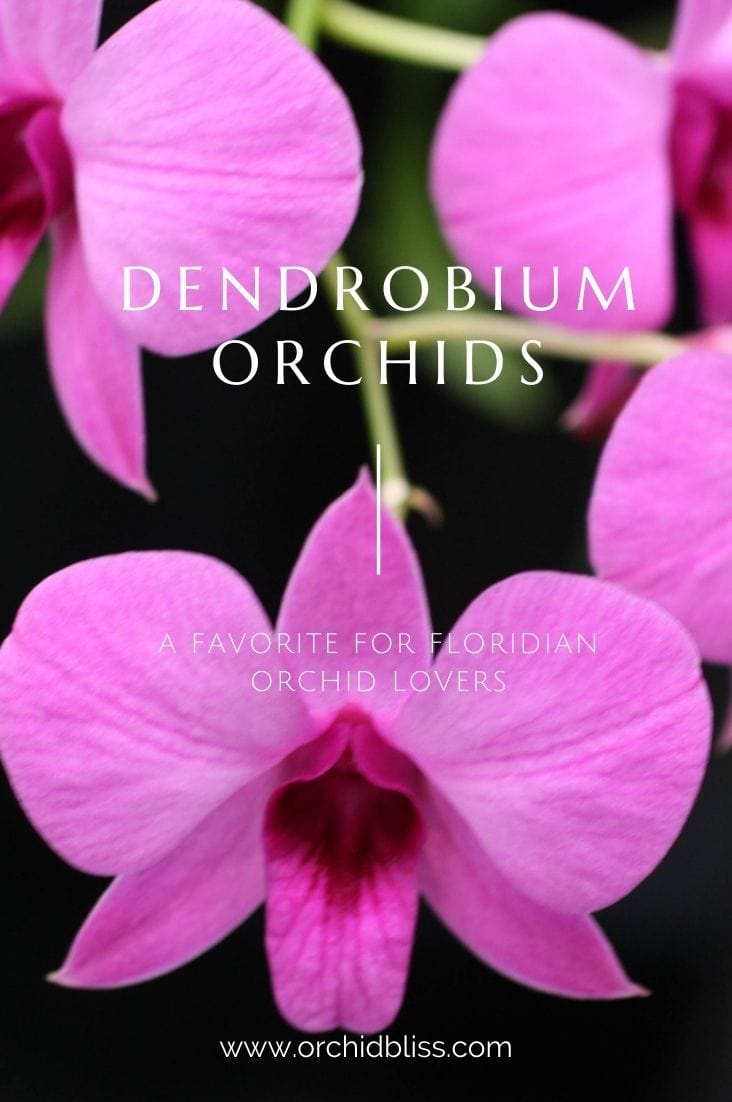
Evergreen dendrobiums are more consistent and are the ideal kind for homeowners in Florida. Keep them in a sunny western or southern window with indirect sunlight, and ensure warm temperatures. They also like moisture, except during the winter months, when they prefer things a bit drier.
Epidendrums
Epidendrums, especially the reed-stemmed or fire-star variety, would do great in South Florida. These orchids are temperature-tolerant and would thrive in medium to bright, full sun.
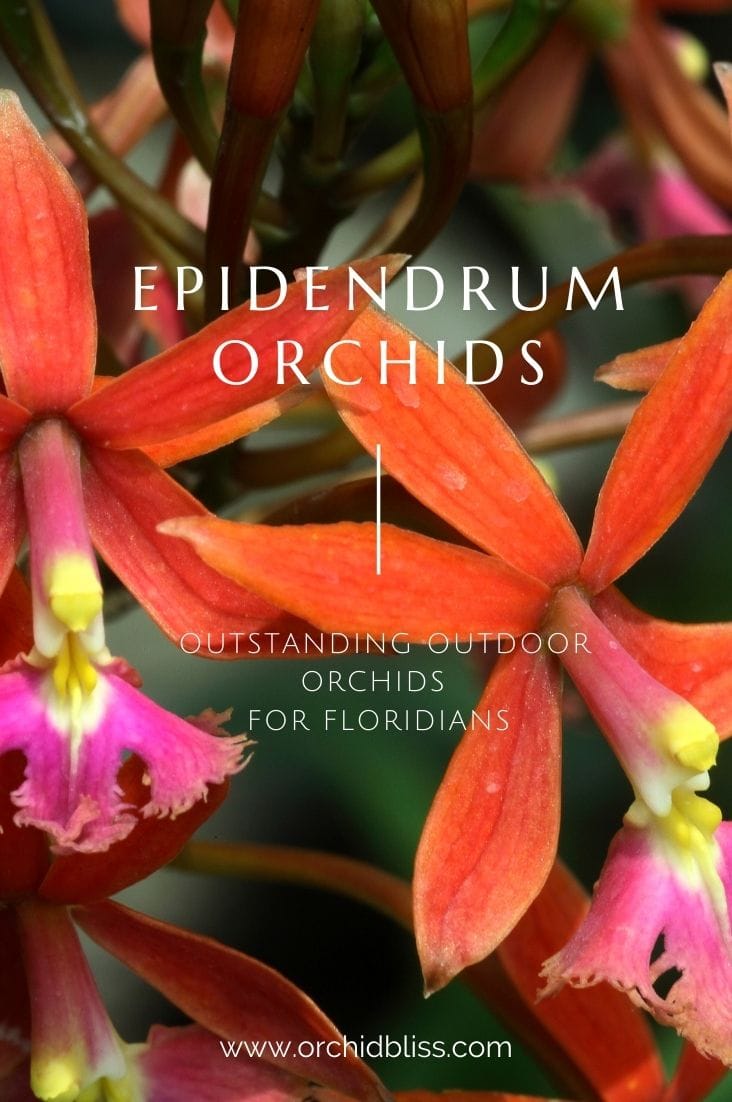
The average temperature during the daytime should be between 60 to 90 degrees Fahrenheit (16 to 32 degrees Celsius), and the average temperature at night should be between 50 to 70 degrees Fahrenheit (10 to 21 degrees Celsius). Epidendrums can tolerate near-freezing temperatures for a short period.
These orchids require frequent and abundant watering, specifically every four to five days during warm months and once a week during cool months.
Oncidiums
Oncidiums do well in Florida’s climate. In fact, one species of this orchid is commonly known as the Florida Oncidium, as it is found in southern Florida, tropical America, and the Bahamas. The Florida Oncidium is also called Dancing Lady.

Oncidiums love the morning sun, even if it is a direct one. In the afternoon, they require shade.
Most Oncidiums prefer intermediate (58° to 62° F/14.4°-17° C) to warm (70-80° F/21°-26.7° C) temperatures, with cooler temperatures at night, and warmer temperatures during the day. They can actually tolerate more heat as long as there’s enough movement in the air around them.
This orchid does not exactly follow a certain watering schedule. All you need is to just check the water levels or the medium’s moisture by pushing a stick or toothpick into it. If the stick comes out dry, then your orchid is due for watering. But if it comes out wet or moist, then hold off for a day or two. Depending on the Oncidiums’ growing season, their watering needs may change from once every two days to biweekly.
Spathoglottis
Spathoglottis are terrestrial or ground orchids. If you live in central or south Florida, or anywhere with a warm environment, ground orchids are great for your flower bed throughout the year. These orchids are grown in pots or containers, then bring them indoors in the fall when the weather starts to cool.
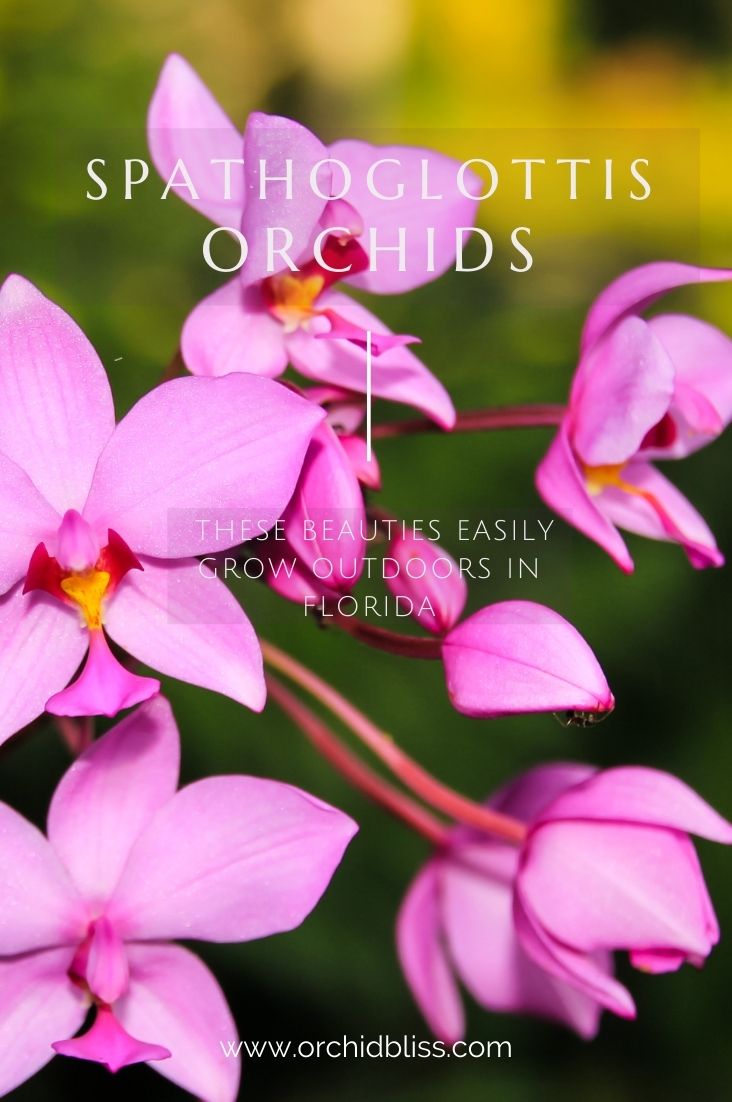
Caring for ground orchids isn’t much harder than growing and caring for other types of bedding plants. These orchids will grow two feet (61 centimeters) tall. They can tolerate light or partial shade as well as full sunlight. The only important element for them is the air temperature, which should be in the high 80s in the daytime and should not be below 50 degrees Fahrenheit (10 degrees Celsius) at night.
Watering is important for these orchids because they need moisture. However, while that is so, they also don’t like their roots constantly getting wet. As such, you will have to water them thoroughly and then allow the top layer or the surface of the medium to dry out completely before your next watering. On average, especially in a protected area, watering is twice a week. But in places that are very breezy or warm, you may need to water more frequently.
Vandas
Vandas prefer warm temperatures, bright light or morning sun, and afternoon shade. When these conditions are right, they will show it through their blooms. In their natural habitat, they grow on top of trees, so they would typically dry out before the next rain comes. So, in cultivation, you need to let your Vanda’s potting medium dry out before your next watering.
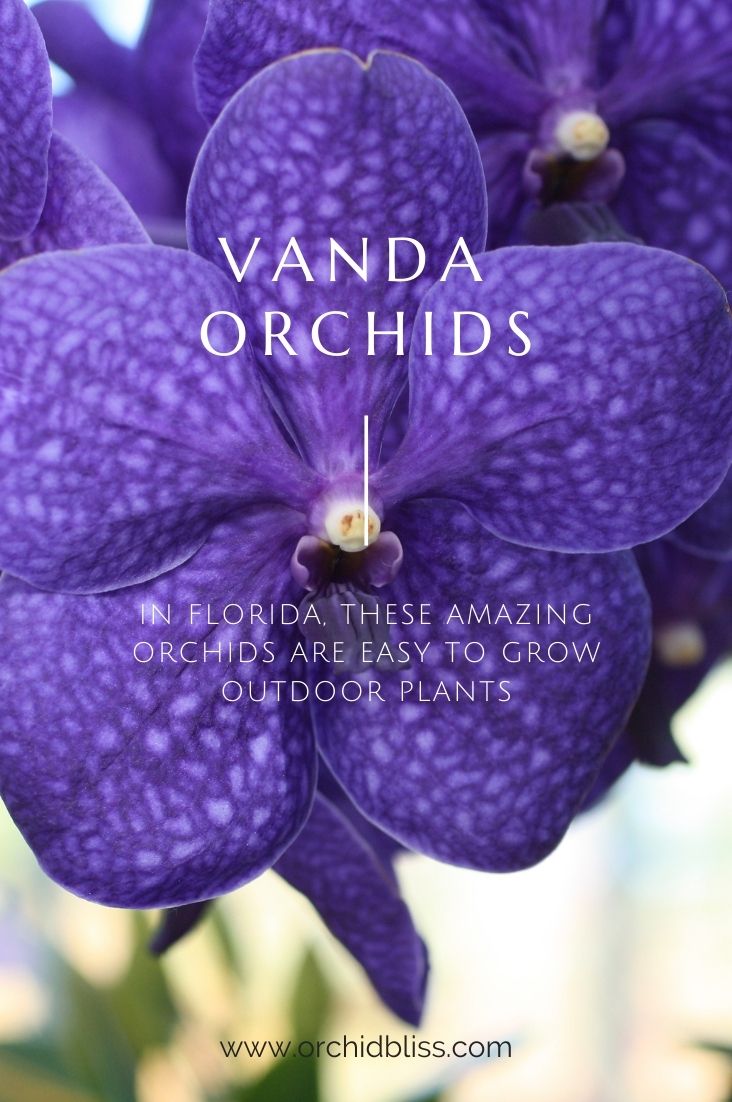
These orchid species thrive in mild temperatures. But while daytime heat isn’t a problem, the harsh cold of winter could cause significant damage.
So, if the temperature is foreseen to go below 50 degrees Fahrenheit (10 degrees Celsius), take your orchids to a shelter or bring them into the house. If you leave them out in 40-degree Fahrenheit (4.44-degree Celsius) weather, these orchids tend to shut down and just quit growing or flowering, and you may have to deal with permanent, irreversible damage.
Vandas prefer a slightly colder environment at nighttime. They can tolerate temperature extremes every now and then, as long as the exposure is for a very limited period and not constant.
During the hot summer months, these orchids will need more fertilizer. You can fertilize them once a week with a balanced nitrogen-potassium fertilizer. Stay away from fertilizers with high nitrogen content during the height of summer. You also need to water these orchids more frequently, but only after making sure the medium is dry.
Miniature Cymbidiums
Cymbidiums prefer to be outdoors in high light. However, during the summer, they can only have filtered sunlight. As such, you can pick a spot for them on a screened terrace or patio or under a tree. These orchids will grow in the ground, on trees, or on rocks.
Throughout the year, these orchids have varied temperature requirements. For one, temperatures have to be within 45 to 55 degrees Fahrenheit (7.2 to 13 degrees Celsius) to promote winter blooms, starting midsummer all through Christmas. Don’t let temperatures go above 85 degrees Fahrenheit (29 degrees Celsius), or it can cause burnt leaves.
You should also know that flowers don’t come easy for standard cymbidiums in South Florida. So don’t expect blooms right away. However, the miniature variety is more tolerant of heat. Water and fertilize at least once a week.
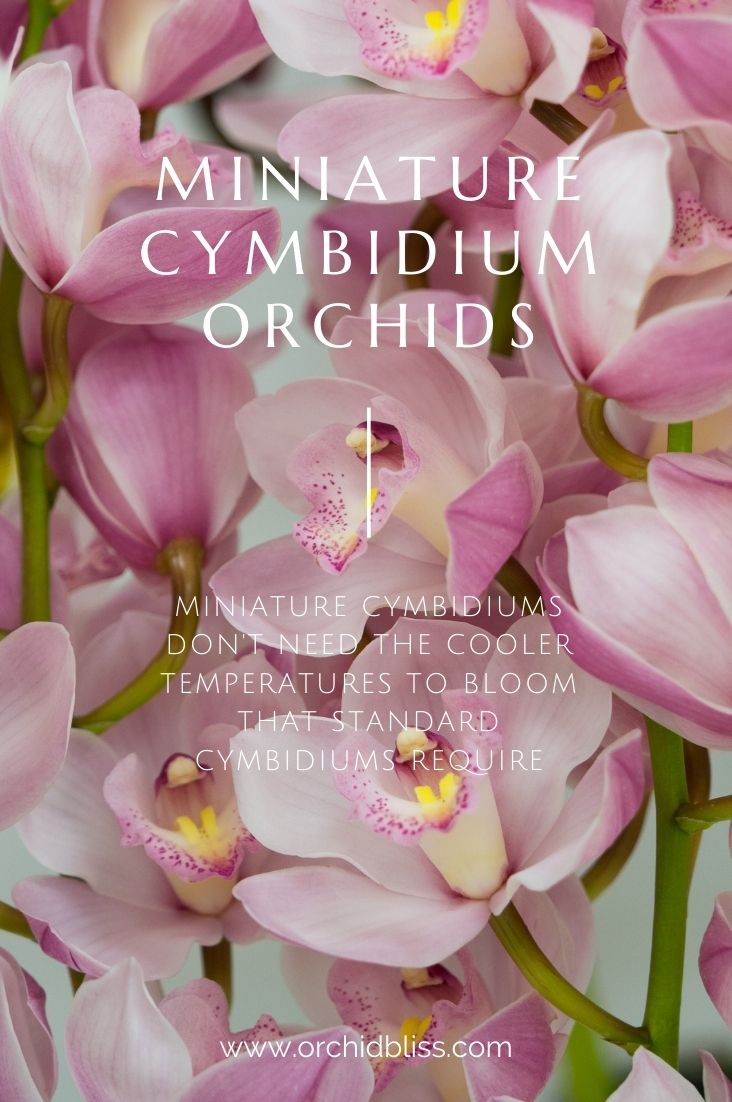
Watering in the morning allows lots of moisture to be drained out before the temperatures cool. Make sure the soil is slightly dry between waterings to keep it from going soggy. The amount and frequency of watering depend on the temperature. Water more frequently in the summer and less in the winter.
Conclusion
Florida is generally warm and humid, and this is why it is nicknamed the Sunshine State. As such, a lot of orchid species would thrive here. The best orchids for South Florida include Phalaenopsis, Cattleyas, Dendrobiums, and Vandas. Some of these orchids love bright and full light, while others prefer some shade.
Most of these plants are also tolerant of heat in the summer and a certain degree of cold in the winter. But regardless of how suitable Florida’s climate is to growing orchids, you will still need to make sure that all other growing conditions are right.
If limp orchid leaves are a problem for your orchids download my free cheat sheet on how to prevent limp leaves and rotten roots. Click here for the super helpful cheat sheet.
Related articles
13 Surefire Ways to Bloom and Grow Cattleya Orchids
If you thought Cattleyas were too tricky, think again
Read24 Beautiful Dendrobium Orchids That Are Easy to Grow at Home
Hey, Windowsill Orchid Growers, This Is for You
ReadSources
- Wikipedia: Climate of Florida
- Climates to Travel: Climate – Florida
- Pro Flowers: Orchid Care Guide: Care Instructions for 23 Popular Orchids
- Crazy Critters Inc: Orchids in Florida
- ArtisTree: Phalaenopsis: The Best Orchids for Your Southwest Florida Home
- Sun-Sentinel: Orchids that Can Take the Heat
- Sundance: Cattleyas
- Sundance: Vanda
- SFOrchid: Summer Orchid Growing Tips
- Southern Living: Dendrobium
- Florida Gardener: Paphiopedilum

